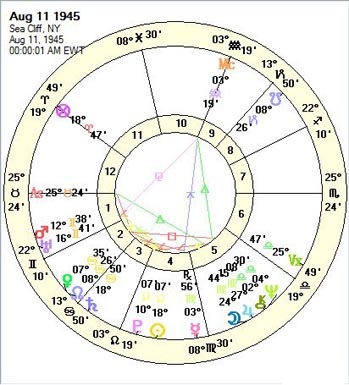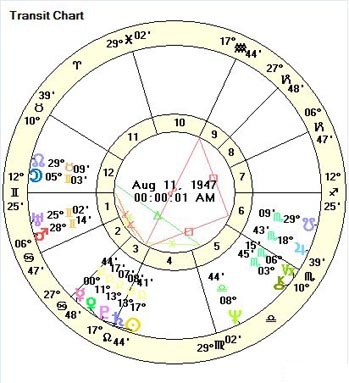...Star-crossed
combinations you
probably
can't avoid, but should...!
By
John Townley
Personal
chart comparisons
(synastry and composites) are an
important area in astrology, and the general rule to avoid trouble is
to keep other people’s
malefics (especially Saturn, Uranus, Neptune,
and Pluto) off sensitive points
in your
chart. And, in looking at composite charts, you don’t want to
find those
already troublesome planets tied up in additionally troublesome
aspects. But
avoiding those kind of contacts can be a bit like crackwalking
– they’re
everywhere and you never know when they’re going to pop up
and spoil a
relationship.
Well,
they’re not quite
everywhere – in fact, they come in predictable patterns
that you can avoid ahead of time, turning your
search into
something more like planned hopscotch than random crackwalking. It may
mean,
however, learning to be wary of whole generations of people that may,
often
unintentionally, not have your best interests in mind.
Synastry
In simple
chart comparison,
it’s important to keep someone’s
malefic off you, hopefully entirely. That’s how simple
jury-picking with
astrology is done, such as the Joanne Little trial where an
astrologically-picked jury got an unexpected acquittal, simply by
keeping the
jurors’ malefics off the defendant’s chart. Having
done the same for civil
trials, I can attest to the efficacy of the simple technique.
It’s not that
folks with malefics on your chart have anything against you personally,
they
just can’t help but move in ways that don’t do you
any favors when they impact
your chart. So depending where your most
tender spots are –
the Moon, the
nodes, Venus, Ascendant, MC in particular – you’ll
find that whole years have
malefics (especially for the outer planets) in those degrees and
will be
years you’re better off avoiding, or at least being wary of.
It’s easy enough
to make a list, which will give you three
to avoid for the outers and
two or
three for Saturn – for each sensitive spot in your chart, maybe a
couple of dozen red-flag
spots in all.
And, you can throw in
Mars on a couple of them, too, as it’s not so nice on your
South Node, maybe
dicey on your Ascendant and Moon as well, though exciting on your Venus
(which
Saturn, say, very much is not).
Composites
Composites
are a little more
tricky, since exactly how two
charts will combine can be a little flippy. For instance, you can never
have a
composite Ascendant more than 90 degrees from your own, and a trine and
a
sextile between the same two planets in two different charts
counter-intuitively
turns into a composite square, except when it doesn’t! But there
is a
generational rule
that pretty broadly applies. That is: when a difficult sky aspect
happens midway in time
between your birth year and another’s birth
year, that difficult
aspect will be in your composite chart. Take, for instance, the
Saturn-Pluto
conjunction of 1947 – if you were born in 1945, two years
earlier, that would be in your composite with people born in 1949, two
years later. For boomers, the most pervasive of these is the
Uranus-Neptune square culminating in 1956 but spread out over several
years
before and after that date. That means that early boomers tend to have
that
square in their composites with late boomers, born on the other side of
it, making them a little uneasy with each other. And for everyone, it
can mean that a single year or even half
a generation
can have built-in trouble
waiting, so you may save yourself a
lot of time by steering clear of close involvements there wherever
convenient. It doesn't mean they're the enemy, just that they can trip
you up without necessarily even meaning to, simply by ringing out of
tune (increasingly so with prolonged contact) when involved with you,
and vice versa.


Two charts just
four years
apart don't seem to have fundamental Saturn-Pluto problems, but...


...when the date between them has
Saturn-Pluto conjunct (l.), so does their
composite (r.), with Venus entangled, too!
And the
problem
is not so much the
single aspect itself, but the
fact that it often serves as the base for other planets attaching to
it like a
tree, making the composite yet the more difficult for it.
Here’s a list of recent
years to look out for:
1936
Saturn-Neptune opposition
1949
Saturn-Neptune square
1947
Saturn-Pluto conjunction
1956
Uranus-Neptune square
1953
Saturn-Neptune conjunction
1955
Saturn-Pluto square
1963
Saturn-Neptune square
1966
Uranus-Pluto conjunction, opposition Saturn
1972
Saturn-Nep opposition
1975
Saturn-Pluto square
1977
Saturn-Uranus square
1980
Saturn-Neptune square
1983
Saturn-Pluto conjunction
1989,
thru 94 Uranus-Neptune-Saturn conjunction
1993
Saturn-Pluto square
2000
Saturn-Uranus square
2003
Saturn-Pluto opposition
2007
Saturn-Neptune opposition
2009-10
Saturn-Uranus opposition
2011 and ahead Uranus-Pluto square
If any of
these dates is halfway
between your birthday and
someone else’s, you don’t even have to draw up a
composite chart to know the
difficult aspect will be there, and perhaps with add-ons that make it
even
more complicated. Of course, the
same
applies for benefic aspects as well, like the lengthy Uranus-Neptune
sextile of
the late twentieth century,
but there’s just not room to list them all
here. It’s easy enough to look them up for yourself, now that
you’ve got the
idea.
In sum, with
all these sky-traps
awaiting your possible
composites, not to mention ordinary synastry crossovers to be wary of,
it can
be a challenge to find a totally
affliction-free relationship
– maybe that’s one reason
why marriage is rarely a perpetual honeymoon. Still, there are plenty
of nice
corners in space and time that make for heavenly combos if you
look
long enough
or just luck into them. And, every tool like this that makes it a bit
easier -- and
helps you get there sooner -- means more time to enjoy it once
you’ve arrived…

